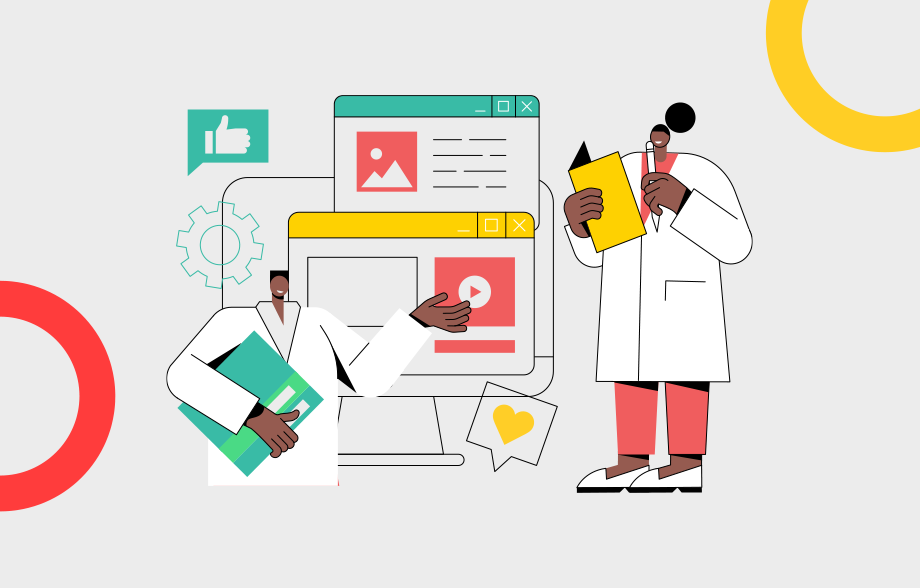Digital Medical Marketing: The New Wave of Healthcare Marketing
Websites have grown more sophisticated and intricate over the years as healthcare advertising has progressed. Customers first had to do an online search to locate the phone number. Early websites frequently prioritised aesthetics above recommended practises for eliciting a reaction. With digital medical marketing a neighbourhood private medical practise can now compete with long-standing hospitals. Their websites serve as the central centre for all of their advertising initiatives in the healthcare sector.
Thanks to the internet, there has been a seismic shift in how consumers interact with healthcare in recent years. Massive changes are already evident in the healthcare industry, including the emergence of telemedicine, virtual reality, R&D, and even artificial intelligence.
Therefore, if you are in the healthcare industry, this is the perfect time to increase your online presence and reach consumers where they search first—online. The most effective approach to do that is to have a strong digital medical marketing strategy.
You need to give importance to digital medical marketing to stay ahead. Here is everything you need to know about digital marketing for healthcare.
Why is Marketing Important in Healthcare?

Here are a few key points to help you understand why digital medical marketing is important:
-
Being more visible online might help you get a lot more patients in the very competitive medical sector.
-
A successful campaign might cause your company’s income to soar.
-
Obtain more loyal clients.
-
Enhance your standing in the industry.
Let’s look at some major benefits of digital medical marketing.
CPA (Cost Per Acquisition)
Your overall ad budget might be decreased by putting into practise a digital marketing for healthcare plan to attract new customers.
A US study found that medical facilities spend over $314 and $348 per patient, respectively, on print and television advertisements.
Compared to what they’ll spend on executing a digital marketing for healthcare campaign, this is a significant sum of money (over 50 percent per in ad spend).
Targeting depending on location

Healthcare facilities have the potential to target a certain population through healthcare marketing online, including age, sex, geography, and more.
Patients will be able to interact with you more easily and have a better customised experience as a result.
Data-driven judgments
With traditional marketing, finding a patient’s information might be challenging, but with healthcare marketing online, the procedure is simple.
Plus, using digital medical marketing makes it simpler to make a well-informed, data-driven conclusion.
Increased prominence in search results
Google searches for information on health and wellness, signs of diseases, nutrition advice, and other topics account for one out of every twenty searches.
You may improve your chances of showing up on Google’s first page by using smart digital marketing and search engine optimization.
More patient recommendations
Digital medical marketing gives you access to a number of expert tools and programs that help scale your campaign for maximum effectiveness and generate qualified leads for your healthcare business.
How to Use Digital Medical Marketing

We know that healthcare marketing online is important, but how do you go about incorporating digital marketing for healthcare?
Here are some steps and tips to follow to start digital medical marketing.
Make a Local SEO Plan

User experience and search engine optimization go hand in hand. Scaling a profitable healthcare company requires the application of an effective local SEO strategy.
Some of the elements that set a website apart from the competition are responsive design, quick website load times, mobile and voice search optimization, simple navigation, and high-quality content.
SEO, a digital marketing tactic, increases your online presence. With the aid of a qualified SEO service, you may increase user experience, brand recognition, and traffic to your website while focusing on a particular area.
Take a look at these data demonstrating the value of SEO for your medical practise.
-
Google, Bing, and other popular search engines are used by 77% of persons who conduct internet searches for health-related information.
-
People are more likely to contact a medical centre when they search for an optician, therapist, or nursing home online.
-
When searching for health-related information online, more than 70% of users never browse past the first page of results.
-
47 percent of internet users search for further details about a physician or a medical facility.
Geotagging
You may attract targeted consumers to your website or mobile app by geotagging your location in your digital content and employing long-tail SEO search phrases.
For instance, it would be a good idea to launch marketing campaigns and develop original content around themes like “best doctors in Philadelphia,” “medical treatments in Philadelphia,” “Doctor care Philadelphia,” or, to be more precise, “Where is the greatest physician practise in Philadelphia.”
Having your dental office appear for all of these keywords on the first page of search results will bring in highly targeted patients.
Take Pay-Per-Click Marketing into Account
You only have to pay for PPC advertising when a lead clicks on your ad, which is a service offered by search engines, social media, and other platforms.
Google AdWord is one illustration; it provides both text and graphic adverts. Text advertising are the advertisements you see on search engines’ first page.
Display adverts that occasionally appear on your screen are known as image ads. These advertising’ algorithms are based on your search history.
PPC advertisements make your website for healthcare services accessible on search engines and increase visitors.
You may track the development of your PPC advertising to find out what is and is not working.
These figures demonstrate the significance of PPC advertising in the healthcare sector.
-
In 2020, the global healthcare sector is expected to spend $36 billion on advertising.
-
PPC advertising cost more than $10.1 billion for more than 7 million healthcare facilities.
-
On average, for every $1.60 spent on Google advertisements, healthcare providers receive $3 back.
Social Media Promotion and Marketing

Social media is used by the healthcare industry to connect with more individuals, including potential patients.
Hospitals and medical professionals may target certain demographics through social media digital medical marketing, including age, sex, region, and more.
You may use social media marketing to promote your healthcare business as well as to inform people about various health issues, offer advice on maintaining good mental and physical health, and much more.
The significance of social media in the healthcare sector is demonstrated by the numbers below.
-
In the US, 94.41 percent of medical facilities have a Facebook page, 50.82 percent have a Twitter handle, 99.14 percent use Yelp, and 99.41 percent use Foursquare.
-
Sixty percent of social media users appreciate expert online health advice.
-
Social media has been used by 83 percent of American internet users to hunt for health-related information.
-
91 percent of social media users admitted that the health information they sought up on social media had improved their decision-making.
Content Marketing
As in many other sectors, content marketing has shown to be one of the best methods for healthcare professionals to interact with their audience.
You may share your knowledge with patients through articles, blogs, infographics, videos, and more thanks to content digital medical marketing.
If you’re a dietitian, you may, for instance, impart advise on healthy eating, exercise, and much more.
The objective is to deliver insightful material. Avert using your content to promote products. Concentrate on adding value, and everything else will take care of itself. Also, try to limit your use of medical terminology. Your material is less engaging as a result.
Less medical jargon in the content makes it easier for readers to grasp and interact with it.
The significance of content marketing in the healthcare industry is demonstrated by the following data.
-
Healthcare content marketing yields a 62 percent lower ad spend than other digital medical marketing strategies and a three times higher return on investment than outbound marketing.
-
Marketers of healthcare videos generate 66 percent more qualified leads annually.
-
58 percent of health marketers maintain an updated blog, and
-
83% of health organisations use content marketing strategies.
Mobile Marketing

Everyone, young and old, utilises cellphones. Targeting users of mobile devices like smartphones, tablets, and other portable devices with internet access is the goal of mobile marketing in the healthcare industry.
Some of the well-liked concepts include text messaging, in-game mobile marketing, mobile picture advertisements, mobile search ads, location-based marketing, geofencing, and cross-channel marketing.
Mobile marketing enables you to provide health-beneficial information, build your reputation, and reach a larger audience.
The effectiveness of mobile marketing in the healthcare industry is demonstrated by the following data.
-
47.6 percent of emails related to healthcare are accessed on mobile devices.
-
44 percent of those who search for hospitals on their phones schedule an appointment.
-
19% of mobile users have applications for fitness and health on their phones.
Spend Money on Email Marketing
One of the most economical methods to keep a positive, close-knit relationship with your patients is through email marketing.
Use demographic information like age, interest, location, health, and more to customise your email correspondence.
Create welcoming greetings, alluring topic lines, and calls to action at all times.
Putting in place an efficient email marketing plan will help your hospital attract more patients and leads.
The effect of email marketing on the healthcare industry is seen by the figures listed below.
-
For every $1 spent on email marketing, the ROI is $44.25.
-
Email is 40 times more successful than Twitter and Facebook when it comes to gaining new leads.
-
89 percent of digital health marketers indicated email is the key source of their lead generation.
We’ve spoken about meeting potential clients when they start seeking for healthcare online, but there are many benefits to approaching individuals before they ever start exploring.
Email marketing has shown to be an economical approach to keep in touch, provide crucial information, set up automated appointment reminders, and involve patients.
The average email open rate for health-related communications, according to the MailerLite data, is 23.46 percent, with a very high click-through rate of 3.62 percent.
Additionally, 90 percent of individuals would prefer a doctor’s office that offers email communications, and 75 percent of adults who use computers truly desire branding, shopping, and other information via email.
Newsletters, welcome emails, webinar invitation emails, season’s greetings, and sign-up forms for your blogs and other channels are just a few things you may include in your email digital medical marketing strategy.
The three main tactics in a successful email marketing campaign are segmentation, customization, and automation.
These tactics will enable you to more effectively split your subscriber base into smaller groups depending on a variety of criteria, enabling you to send more precise emails.
HealthLine makes use of email segmentation to market material to contacts who have a common interest in that issue.
Set Up a Blog
Well-written, SEO-optimized medical blogs are a terrific method to draw them to your organisation or clinic and may help you rank on search engines since 77% of people use search engines to begin their medical journey.
People frequently find comfort in reading about other patients who have through a therapy, ailment, or procedure they are now undergoing.
Therefore, planning your editorial calendars around health months or other timely issues pertinent to your company is a great idea.
By utilising this, you may increase the amount of people who read your site.
This may be seen, for instance, in the Harvard Medical School Blog, which consistently publishes articles on a range of medical topics.
Its navigation makes it easier to search for subjects by health subcategories like heart health or men’s health.
The blog subscription is easily accessible to readers, and interaction is promoted by displaying the blog entries with the most comments.
Healthcare Marketing Solutions: Xoopah
With Xoopah, you may reach your patients wherever they may be.
Small and medium-sized healthcare enterprises may flourish tremendously online with the help of Xoopah’s suitable digital platform. Xoopah makes it easier to find, serve, and keep new clients by giving your company the right visibility.
The All-in-One customer interactions platform from Xoopah enables a fresh and creative method to communicate and provide effective patient care. Increase the revenue and expansion of your small healthcare business by providing it with the modern-day digital connectivity it needs.
Send patients in your small healthcare firm email updates, share reports, and run marketing campaigns and promotional offers.
Share appointment reminders, payment dues, links to reports, and promotional information with patients to streamline communication.
With the help of Xoopah’s unified customer interaction platform services, you may lessen the need for numerous software programs and platforms to manage patient contacts and improve your healthcare organisation.
Final Thoughts: Digital Marketing for Healthcare
When you have the desired outcomes, it’s one thing to get them; nevertheless, maintaining success requires ongoing evaluation and plan revision.
This requires a lot of time and effort on the part of a medical practitioner. There is no way around it, which is unfortunate since it causes many firms to stagnate.
To guarantee you sustain efforts in digital medical marketing and simplify processes to stay ahead, use the correct technology, such as Xoopah.






